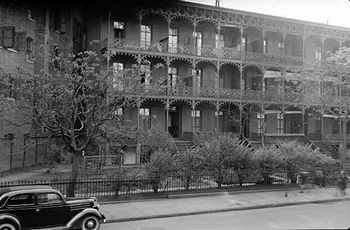Together again in Croton, Florence Deshon and Max Eastman clashed frequently. Florence
 |
| .Movies were purveyors of images of unattainable goddesses and gods. This is Florence Deshon in 1916 |
After completing the manuscript of his book on the sense of humor, Max returned to New York Florence
In the autumn of 1921, Florence returned to New York Europe .
A militant suffragist, Stevens had shared a house in Croton with Malone, an attorney who had resigned as Collector of the Port of New York, a political plum of a job, to protest the rough treatment given to women picketing the White House.
 |
| Florence Deshon's subleased apartment was in Rhinelander Gardens on West 11th Street. Photographed by Berenice Abbott in 1937.
The Stevens apartment was in
Located on the south side of
|
 |
| Detail of the cast iron balconies at Rhinelander Gardens as photographed by Berenice Abbott in 1937.
According to Max, Friday night, February 4, 1922, he was attending a Broadway play with artist Neysa McMein when a man tapped him on the shoulder and whispered, "Florence Deshon has been taken to the hospital. She turned on the gas in her room. She's in
Earlier that day, Max had met Max rushed to the hospital and was told that Eastman later recounted the story of their flawed romance and A news story in The New York Times for Saturday, February 5, 1922, reported that Ms. Minnie Morris, described as a newspaperwoman, had returned to her apartment Friday night and detected the odor of gas. She found A follow-up story in the Times on Sunday, February 6, reported, "None of the friends of Florence Deshon, film actress, friend of Charlie Chaplin and of Max Eastman, could find the least motive yesterday in her death. All declared the gas must have been turned on accidentally, and the Medical Examiner has reached the same conclusion." Funeral services for her were held at noon Monday, February 7, at Frank E. Campbell's Rumors persisted, however, that she had killed herself over personal problems. Some even suggested that she had quarreled with Max. One neighbor told about a dispute that had taken place in When a Times reporter contacted him, Max strongly denied the charge: "It is absolutely false. Miss Deshon was a dear friend of mine, and I am sure her death was accidental. There was no reason in the world why she should take her life, and no letter has been found or received to indicate that she did. She was healthy and happy when I saw her, on Thursday afternoon [not Friday afternoon, as his book has it], and we had an engagement for the theatre on Saturday. Please do not question me any more about it." The Sunday Times story reported that Max had gone to the hospital on Saturday morning [not Friday night], when doctors made a final attempt to revive her, and a blood transfusion was performed. It concluded with the news that at the time of her death the offer of a part in a play was awaiting her acceptance. Not long after the funeral, Eastman left on a planned trip to an international conference in He was trailed by many questions: Was Florence Deshon's death an accident? A suicide? How to account for the open window in February? Had the flame been lit and blown out by a draft of air? Why would the gas have been lit when electric illumination was available? And how to explain the absence of a farewell note from a young woman who regularly poured out her soul in letters to friends? The past guards its secrets well, and the big question remains unanswered: What were the true circumstances behind Florence Deshon's death? |
Epilogue
In 1955, the eight row houses of Rhinelander Gardens
For years accounts of Florence Deshon’s career and death have maintained that her grave site was unknown. Cemetery records were scoured in her birthplace, Tacoma, Washington, and Hollywood, California, to no avail. Nor was she buried in the Actors Fund plot in Kensico Cemetery in Valhalla, N.Y. or in the earlier Actors Fund plot in the Cemetery of the Evergreens in Brooklyn, N.Y.
Diligent research, however, has solved this mystery. It turns out that Florence Deshon was quietly buried inNew York Mt. Zion Cemetery in Maspeth in the borough of Queens , along what is designated as Path 10 in the Left Section of the cemetery.
Diligent research, however, has solved this mystery. It turns out that Florence Deshon was quietly buried in
Beautiful Florence Deshon was only 28 years old when she died mysteriously. She joined two other creative artists associated with Broadway and Hollywood who also died young and are buried in Mt. Zion Cemetery
No comments:
Post a Comment